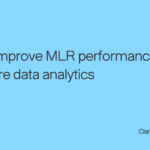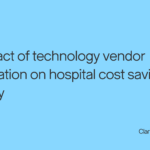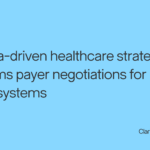Taking advantage of technological advances like AI, health plans can streamline manual processes such as prior authorization to reduce operating costs and improve margins. With the power of big data, payers can also offer providers clinically based alternatives to prior authorization. By streamlining the approval process for medical services, health plans can reduce unnecessary expenditures, minimize claims denials, and increase patient and provider satisfaction. Prior authorization (PA) is a process in which health plans require healthcare providers to obtain approval before performing certain medical procedures, prescribing specific medications, or ordering costly tests and treatments. In theory, PA reduces unnecessary care costs by adding a layer of review where the payer confirms the proposed healthcare services are medically necessary and meet quality guidelines. Prior authorization assists health plans in managing healthcare costs by ensuring that medical procedures, treatments, and medications adhere to established guidelines and medical necessity criteria, preventing the misuse or overuse of healthcare resources. By scrutinizing and approving only essential healthcare services, payers can contain expenses, mitigate fraud, and maintain a sustainable financial model — all while delivering quality care to their beneficiaries. Healthcare utilization can be a significant driver of escalating costs within the industry. With prior authorization, payers have a safeguard to ensure patients receive treatments tailored to their medical needs. This can protect patient well-being and ensure the financial sustainability of the U.S. healthcare system. While the idea behind prior authorization – cost containment and spending accountability – sounds like a win for everyone, from the patient to the payer, doctors and health plans report that prior authorization creates undue administrative burden. According to a brief by EY, “in their current form, these non-standardized, manual processes present challenges for the smooth processing of PAs, including physician burnout, huge costs to health care, delays or absence of appropriate care for patients, and a suboptimal stakeholder experience.” But it doesn’t have to be this way. Advanced technology and automation drive efficiency, cost savings, and quality in nearly every industry. The 2022 CAQH Index found that digitizing the prior authorization process could save $449M annually and an overage of 11 minutes in time savings per transaction. Implementing an automated prior authorization system can yield substantial financial benefits for payers by decreasing administrative costs, reducing claims denials, and improving revenue cycles. This streamlined approach ensures that valuable resources are redirected towards delivering quality healthcare services, leading to a better experience for patients and providers. However, taking advantage of the latest technology to streamline prior authorizations requires a strong technological infrastructure and interoperability to facilitate the seamless exchange of information between providers and payers. This includes EHR systems, claims processing software, and communication platforms that can efficiently handle authorization requests and responses. Integration of these systems is essential to streamline the process, reducing administrative burden and minimizing delays. This type of interoperability may seem like a pipe dream for some health plans, leading them to look outside the traditional prior authorization model to drive new efficiencies. Using the power of big data, health plans can evaluate provider performance with greater accuracy, fairness, and precision than ever before. Using these insights to drive their strategy, many leading health plans are investing in alternatives to prior authorization to drive high-value, cost-effective care for their members. Some alternatives to PA include gold card or preferred provider programs, centers of excellence, and value-based contracting. Gold carding, or preferred provider programs, can reduce the burden of prior authorization by pre-authorizing certain providers to order patient care or services. Payers grant high-performing providers with a proven track record of delivering high-quality care and adhering to best practices a special status that expedites their claims processing and prior authorization requests. This status is akin to a “gold card” and is typically reserved for trusted providers with a history of low error rates and compliance with billing and documentation requirements. Gold carding can significantly reduce administrative burdens for healthcare providers and payers, streamlining the claims and authorization processes and allocating resources more efficiently. Furthermore, gold carding hastens the prior authorization process by eliminating the need for rigorous scrutiny of requests from trusted providers, allowing them to receive approvals faster. This increased speed and efficiency also benefit patients, reducing delays in accessing necessary treatments and services. Using big data efficiencies to gather and analyze provider performance data on cost, quality, and outcomes, many payers are finding the best providers in a given market and setting up Centers of Excellence or COEs. Hospitals selected as CoE participants are trusted to provide quality care and demonstrate above-average positive patient results while providing overall cost savings. Thus, if a member goes to a COE for their care, the preferred providers and specialists are not required to obtain prior authorization. For payers further along in their automation journey, value-based arrangements may present an opportunity for lighter prior authorization requirements. For example, if contracted providers are meeting performance benchmarks on quality measures, demonstrating adherence to evidence-based guidelines, or meeting other performance targets, the payer can identify specific drugs, services, or procedures that could have prior authorization requirements waived or reduced. However, if a value-based program specifically aims to reduce unnecessary utilization, PA is often a critical tool for supporting the desired behavior change. While there are substantial technological and financial investments needed to set them up, advanced analytics can improve care efficiency and reduce administrative burden by unlocking alternative utilization management practices outside of prior authorization. To drive further revenue optimization, payers can implement new technology, such as clinical decision support, into their prior authorization practices. Clinical decision support refers to technology-driven tools and systems that give providers real-time information, recommendations, and guidance to assist them in making well-informed decisions about patient care. Its importance lies in enhancing patient outcomes by helping clinicians navigate the complexities of modern medicine, reducing errors, and ensuring that care aligns with evidence-based guidelines. Clinical decision support systems empower healthcare professionals with immediate access to relevant patient data, the latest research, and treatment options. This allows for more accurate diagnoses and personalized treatment plans. Payers should prioritize developing strong clinical partnerships and utilizing evidence-based criteria in prior authorization management. Applying physician-supported, evidence-based criteria, payers can reduce the administrative burden on providers, streamline the authorization process, and minimize delays in delivering essential care. To build an evidence-based criteria framework, payers should assemble a multidisciplinary team of clinicians, researchers, and experts in the relevant medical specialties — collaborative efforts with these stakeholders are essential for developing and refining criteria that reflect the latest clinical evidence and best practices. Regular meetings, feedback mechanisms, and ongoing engagement with these experts will ensure that the criteria framework remains current and aligned with the ever-changing healthcare landscape — ultimately strengthening the payer’s ability to make informed decisions in prior authorization management. Utilizing data analytics is also integral to developing and refining an evidence-based criteria framework, as it allows payers to systematically analyze vast datasets, identify trends in treatment outcomes, and track the effectiveness of prior authorization decisions over time. While prior authorization was spurred by an urgent need to curb rising costs in healthcare, the time and labor required to uphold the system is a drain on the industry. Using advanced technologies, health insurers can take more innovative approaches to reducing healthcare spending while maintaining the health of their member populations. Investing in automation will reduce administrative costs and employee burden, decrease claims denials, and improve financial performance overall while ensuring timely access to appropriate healthcare services for members. To help accelerate their digital transformation and drive financial success, payers may seek specialized assistance from managed services and data analytics providers. These strategic partnerships can offer valuable expertise, advanced technology, and data-driven insights, enabling payers to enhance efficiency, decrease expenses, and deliver more effective, evidence-based healthcare management. Understanding prior authorization in healthcare
Prior authorization creates an undue burden on healthcare stakeholders
Streamlining prior authorization with automation
Alternatives to prior authorization
Enhancing prior authorization with clinical decision support tools
Strategies for efficient prior authorization management
Conclusion
- Author Details





